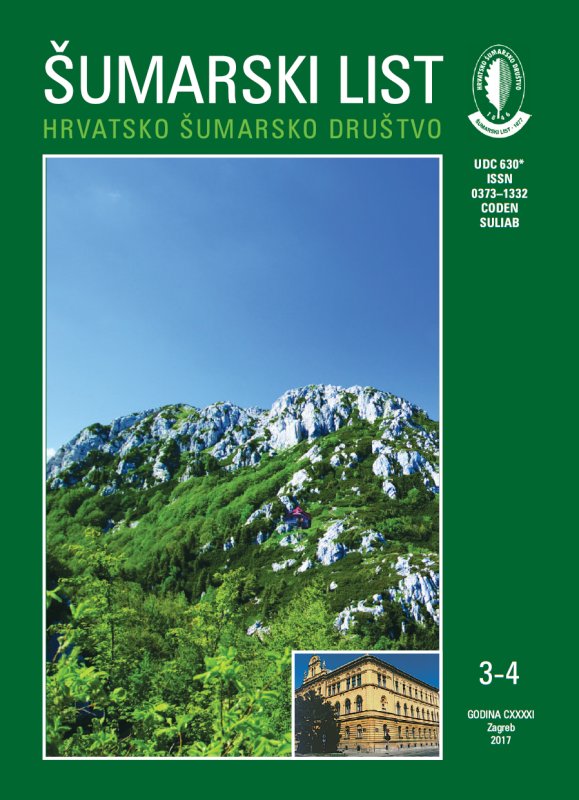
broj: 3-4/2017
pdf (15,8 MB) |
|
||||||||||||||
| RIJEČ UREDNIŠTVA | ||
| Uredništvo | ||
| WHAT, IF ANYTHING, HAS CHANGED? pdf HR EN | 113 | |
| IZVORNI ZNANSTVENI ČLANCI | ||
| Jelena KRANJEC, Marno MILOTIĆ, Marija HEGOL, Danko DIMINIĆ | UDK 630* 449 (001) https://doi.org/10.31298/sl.141.3-4.1 | |
| FUNGUS-LIKE ORGANISMS IN THE SOIL OF DECLINING NARROW-LEAVED ASH STANDS (Fraxinus angustifolia Vahl) pdf HR EN | 115 | |
| Ali DURKAYA, Birsen DURKAYA, Ali SABANCI, Sinan KAPTAN | UDK 630* 537 (001) https://doi.org/10.31298/sl.141.3-4.2 | |
| EVALUATION OF THE EFFECTS OF VARIOUS FACTORS ON ABOVEGROUND AND BELOWGROUND BIOMASS STORAGE CAPACITY OF EASTERN MEDITERRANEAN MAQUIS VEGETATION pdf HR EN | 123 | |
| Kyriaki KITIKIDOU, Elias MILIOS, Panagiota PALAVOUZI | UDK 630* 582 (001) https://doi.org/10.31298/sl.141.3-4.3 | |
| Development of an ensemble classifier with data from description sheets To classify forest stands in site qualities pdf HR EN | 131 | |
| PRETHODNO PRIOPĆENJE | ||
| Matija STERGAR, Klemen JERINA | UDK 630* 156 https://doi.org/10.31298/sl.141.3-4.4 | |
| WILDLIFE AND FOREST MANAGEMENT MEASURES SIGNIFICANTLY IMPACT RED DEER POPULATION DENSITY pdf HR EN | 139 | |
| Summary Red deer (Cervus elaphus L.) is in many parts of the world ecologically important and highly popular game species. Its population densities and environmental impacts largely depend on habitat suitability, which in turn is under strong influence of humans. Wildlife management intentionally improves habitat suitability, while forestry’s impacts on red deer are mostly unintentional. In both disciplines the full extent of these impacts is poorly understood. To better understand habitat use and improve management of red deer, we studied the impacts of multiple environmental and historical factors, mostly anthropogenic, on red deer spatial distribution in Slovenia. We found that the probability of red deer presence and population density are higher close to locations of historic (> 100 years ago) red deer reintroduction sites and in large continuous forest complexes. The finding is important for forecasting future red deer distribution and population dynamics. Population density is also positively dependent on proximity to supplemental feeding sites, the proportion of spruce stands in pole-stage and the share of forest young growth, which is important for preventing unwanted impacts of red deer on forest. The approach used by this study and its results are also useful for improving habitat ranking of hunting grounds, which some countries use in wildlife management planning. Key words: red deer; habitat suitability; population density; wildlife management; forest management; supplemental feeding; Slovenia | ||
| Ljiljana KEČA, Milica MARČETA, Stjepan POSAVEC, Sreten JELIĆ, Špela PEZDEVŠEK-MALOVRH | UDK 630* 899 https://doi.org/10.31298/sl.141.3-4.5 | |
| MARKET CHARACTERISTICS AND CLUSTER ANALYSIS OF NON-WOOD FOREST PRODUCTS pdf HR EN | 151 | |
| IZVORNI ZNANSTVENI ČLANCI | ||
| Erhan ÇALIŞKAN, Uzay KARAHALIL | UDK 630* 686 + 383 (001) https://doi.org/10.31298/sl.141.3-4.6 | |
| EVALUATION OF FOREST ROAD NETWORK AND DETERMINING TIMBER EXTRACTION SYSTEM USING GIS: A CASE STUDY IN ANBARDAG PLANNING UNIT pdf HR EN | 163 | |


